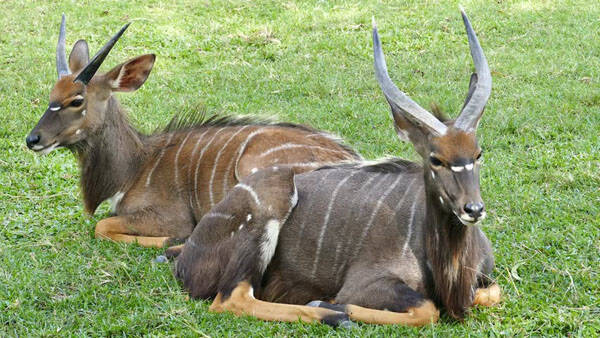Tragelaphus angasii
IUCN
LCBasic Information
Scientific classification
- name:Tragelaphus angasii
- Scientific Name:Tragelaphus angasii,White-striped antelope, white-spotted antelope, East African bushbuck, Anders's bushbuck, African bushbuck, Nyala bushbuck
- Outline:Ungulata
- Family:Artiodactyla Bovidae Sapir
Vital signs
- length:135-195cm
- Weight:98-125kg
- lifetime:About 19 years
Feature
The fur is reddish brown with obvious stripes, very beautiful
Distribution and Habitat
Distributed in southern Africa. Origin: Malawi, Mozambique, South Africa, Zimbabwe.
Restored: Swaziland.
Introduced: Botswana, Namibia.
Prefers to live in dense forests or shrubs near grassland woodlands, and prefers to be close to high-quality grassland with fresh water.
Appearance
The Andersenkoi is a medium-sized antelope, with males and females being dimorphic. Males are larger, weighing 98-125 kg and 1 meter tall at the shoulder, while females weigh 55-68 kg and are slightly less than a meter tall. Both males and females have a long hairy back that runs from the back of the head to the base of the tail. Males are pale blue with long dangling hair on the neck and shoulders and spiral horns on their heads; females and calves are reddish brown, with 8-14 white stripes on the sides of both sexes and a white spot between the eyes. Males have large twisted yellow horns that are spiral-shaped and about 60-83 cm long. Females have no horns or long hair. The fur is reddish brown with distinct markings, which is very beautiful.
Details
Lowland Nyala (scientific name: Tragelaphus angasii) is called Lowland Nyala in foreign language, and has no subspecies.

Lowland Nyala usually live alone or in small groups of 10. They have low territorial awareness, are shy, cautious, and highly vigilant. Males will stab their prey with their sharp horns if in danger. If threatened, females will band together, often in groups that can number up to 30 individuals.
Female Andrei offspring sometimes remain in their mother's group, so relatedness within a female group can be relatively high. Males also form groups, but these associations are more transient, with no long-term associations between specific male relatives. The species is not territorial, and home ranges often overlap. Large numbers of Andrei may converge on a good pasture or water source. Adult males will fight if females are in estrus. A male will show off to another male by raising the white mane on his back, raising his head, and holding up his tail. If an intrusion occurs, it will use violence. Males have been known to be killed by the horns of their rivals. Generally, the larger of the two males is the winner and then mates with the female. This species has a variety of stereotyped behaviors associated with dominance interactions and courtship.
Andrey's bushbucks are active during the day, but more common activity is concentrated in the early morning and evening. They are cautious animals that move only in dense underbrush, where they spend most of the day hidden in the brush where they can hide from predators and the intense heat of the day. They are vulnerable to certain predators, and members of the female group will sound the alarm, sending deep barking calls to other members within earshot. They also respond to the alarm calls of several other species, such as impala, baboons, and kudu. Andrey's bushbucks sometimes follow baboons to feed, taking advantage of fruits and leaves that the baboons drop from trees.

Andersenkoi are both foragers and wanderers. They are herbivores, eating leaves, branches, flowers, and fruits of many different plant species. They need to replenish a large amount of water every day. During the rainy season, they mainly eat fresh green grass. They will drink water every day when there is a water source, but can also survive in areas where water is only seasonally available.
Andersenkoi can breed all year round, with peak mating occurring in spring and autumn, with a peak in spring and a smaller peak in autumn. Females have a surface cycle of about 19 days. Males can mate on two days of this cycle, but females only accept mating for 6 hours each cycle. Females have a gestation period of about 7 months and give birth to one calf weighing about 5 kg. The calf is born in the bush, out of sight of potential predators (lions, hyenas, leopards, wild dogs). It stays hidden for up to 18 days, during which time the mother returns regularly to clean and nurse it. The calf lives with the mother until she reproduces again. Andersenkoi live for about 19 years.
Andersenkoi have a limited range. In some areas, their habitat has actually been improved by human activities, such as reforming agricultural technology, abandoning farmland and arable land, restoring shrubs, and controlling overgrazing by cattle on grasslands, which has enabled many plants to grow and recover. These measures have improved the living environment of the Andersenkoye, making the species not close to the vulnerable and endangered threshold standard for species survival (distribution area or fluctuation range less than 20,000 square kilometers, habitat quality, population size, and fragmented distribution area), and the population trend is stable, so it is evaluated as a species with no survival crisis.
Listed in the 2016 Red List of Endangered Species of the World Conservation Union (IUCN) ver 3.1-Least Concern (LC).
Protect wild animals and stop eating game.
Maintaining ecological balance is everyone's responsibility!








